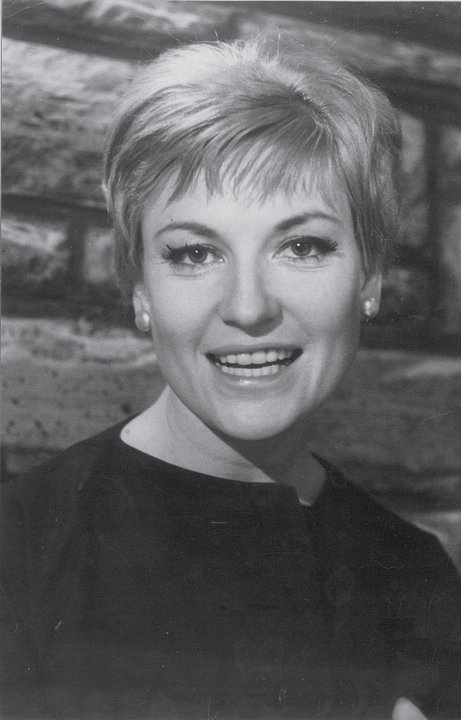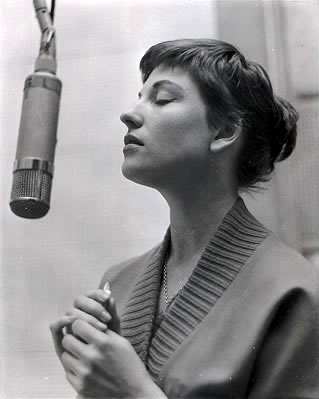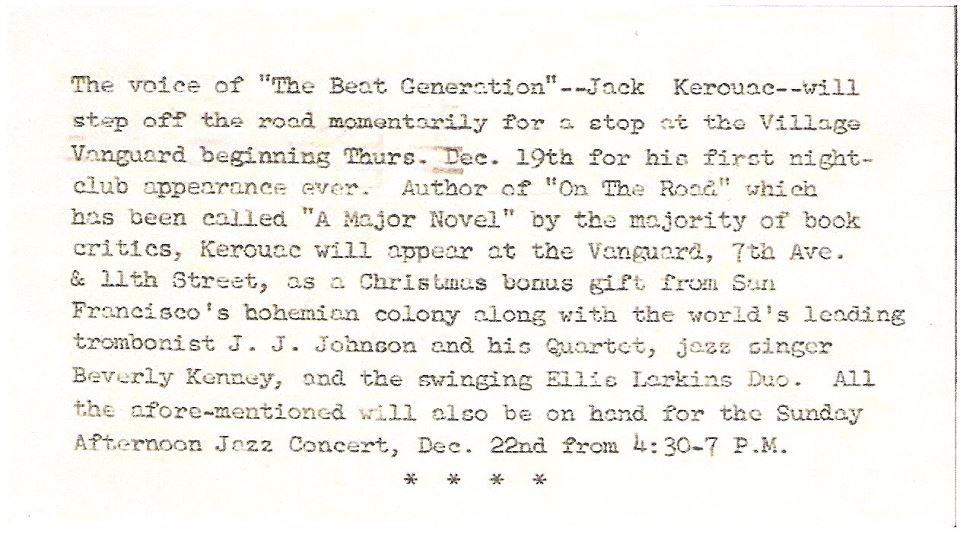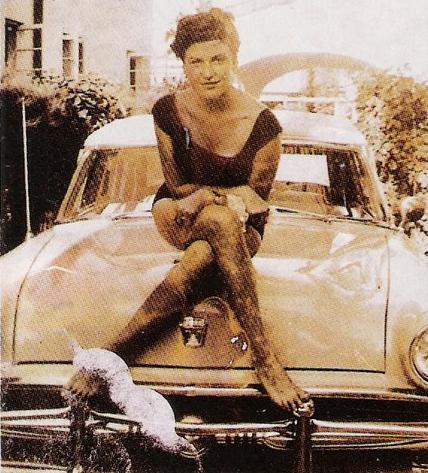The Voice of Beverly Kenney
By David McGee
Fifty-two years ago this month, on April 13, 1960, one of the most distinctive pop-jazz singers of the post-war era swallowed a lethal dose of Seconal and alcohol--dead at age 27. Though seemingly destined for greatness, Beverly Kenney wasbeset by personal difficulties of an unspecified nature. The contents of a note she left her parents remain unpublished. The collapse of romances with the famous Beat writer Milton Klonsky and future advertising executive Mort Lowenstein (who was working at a Bamberger’s department store when he dated Ms. Kenney) drove her to despair, but her problems were more severe than a broken heart. Jazz singer-pianist Audrey Morris, who performed with Ms. Kenney in Chicago, described the singer as “very inside. I don’t mean aloof--she was lovely and nice to talk to. I suspected severe melancholy, maybe mistook it for homesickness as she spoke frequently of Nicky DeFrancis, her very dear friend. I believe he was working at a piano bar in New York.”
Musician Ralph Pratt, who worked with Ms. Kenney on the road in 1956, remembered her as “a great singer…but she seemed pretty unhappy and not too stable, so I wasn’t surprised at her untimely death. A great loss!”
Chuck StewartFor a growing number of fans of classic pop vocalizing, however, Beverly Kenney remains a beacon of exalted, near transcendent artistry who, as her biographer Bill Reed told yours truly in this publication’s April 2011 feature on Ms. Kenney’s life and music, “She was probably the pluperfect example of the very first major singer who came along just five seconds too late. I write a lot about what I call the tsunami of rock and roll that just came and blew everything away. I’m always at pains to say I love rock and roll, but it really drove everything out, just completely blew everything away. So when Beverly died, she was totally broke, and was still being partially taken care of by Mort, although they were no longer lovers, were no longer living together. She had no money.”
Beverly Kenney’s legend grows, not simply because of her tragic end but because her music is finding new advocates across generational lines. Her recordings remain a fixture on the playlist of WNYC-FM and AM’s Jonathan Schwartz, who wrote the first in-depth feature on the artist for GQ in 1992. Bill Reed's ebook has ignited further interest in the singer's work. Now a Facebook group, Born To Be Blue: Fans of Beverly Kenney, is gaining followers--including relatives of Ms. Kenney’s who sometimes post videos and photos from their family archives.
Recently, one of those Fans of Beverly posted a link to mp3 downloads of four remastered tracks recorded for but left off Ms. Kenney’s Decca debut album, 1958’s Sings for Playboys, one of her most beautiful album-length exercises. The album features Ellis Larkins on piano and celeste in a spare, intimate setting capturing the singer in a wee small hours mood of thoughtful introspection leavened by a touch of wry, knowing humor. “A Woman’s Intuition” is a devastating, low-key recognition of something coming apart but also a declaration of intent to make it work, with Larkins adding ruminative, concise piano musings to the close-miked, raw vocal; the saloon-style flirtation of “What Is There To Say”; the wistful longing for companionship in the bluesy piano ballad, “A Lover Like You”; a playful suggestion of impending romance in a soft, probing ballad rendition of “Try a Little Tenderness”; and, resonant of the style of her first album, a frisky, cheery “A-You’re Adorable,” one of Nat King Cole’s classics. If this was her answer to those who said she needed to sing with strings, it could hardly have been more persuasive in her favor.
(Ellis Larkins, who had a chance to observe Ms. Kenney close up on sessions for two albums, described her to Jonathan Schwartz as “very deep,” but added: “You could sense there was inner trouble. She was a loner, in a way of speaking.”)
Here, then, in remembrance, are those four rare bonus tracks from Sings For Playboys, in remembrance of an artist whose voice cannot be stilled.
“Sing a Rainbow”
A beautiful, delicate ballad piano-and-vocal treatment of the Arthur Hamilton song (also known as “I Can Sing a Rainbow”) first featured in the 1955 film Pete Kelley’s Blues, starring Jack Webb as, improbably, a jazz musician. Peggy Lee sang the original version in the movie.
Audio clip: ‘Sing a Rainbow’“Brooklyn Love Song”
was written especially for Marion Hutton, sister of Betty Hutton. Reviewing Ms. Hutton’s appearance at Slapsy Maxie’s in Hollywood in its April 17, 1948 issue, Billboard noted: “In her first nitery stint, thrush Marion Hutton showed plenty of flare for the work. Easy on the eyes and smartly gowned, Miss Hutton puts her lusty pipes to to solid use in a series of specially written tunes, best of which was 'Brooklyn Love Song.' Marion has a tendency to use same mannerisms, gestures and stylings made famous by her sister Betty, a fault which should be promptly corrected. Gal has enough talent to score without resorting to Betty’s trade-marked devices.”
Audio clip: ‘Brooklyn Love Song’“What’s It Like in Paris”
No information available on this one, but it is a beautiful mix of melancholy and innocence, something Ms. Kenney did as well as any artist in her time, or ours, for that matter. Piano and vocal, and exquisite execution, a model of taste and sensitivity.
Audio clip: ‘What’s It Like In Paris’“Time Was/It’s So Peaceful”
In typical Beverly Kenney fashion, she takes “Time Was” (recorded by the Jimmy Dorsey Orchestra) and invests its tender reminiscence of young love with an undercurrent of wariness, only to turn bright and cheery when she skips into Alec Wilder’s pastoral “It’s So Peaceful In the Country.” Rosemary Clooney cut a terrific version of “It’s So Peaceful” on her moving 1996 album, Dedicated to Nelson, a tribute to her long-time lover Nelson Riddle. The definitive version was recorded in 1957 by June Christy, on her concept album Gone For the Day, with arrangements by Pete Rugolo and a band that included Howard Roberts on guitar, Shelly Manne on drums, Red Callender and Red Mitchell on bass and Bud Shank on flute, among other stellar players.
Audio clip: ‘Time Was/It’s So Peaceful’
‘…the pluperfect example of the very first major singer who came along just five seconds too late.’
Founder/Publisher/Editor: David McGee
Contributing Editors: Billy Altman, Laura Fissinger, Christopher Hill, Derk Richardson
Logo Design: John Mendelsohn (www.johnmendelsohn.com)
Website Design: Kieran McGee (www.kieranmcgee.com)
Staff Photographers: Audrey Harrod (Louisville, KY; www.flickr.com/audreyharrod), Alicia Zappier (New York)
E-mail: thebluegrassspecial@gmail.com
Mailing Address: David McGee, 201 W. 85 St.—5B, New York, NY 10024






